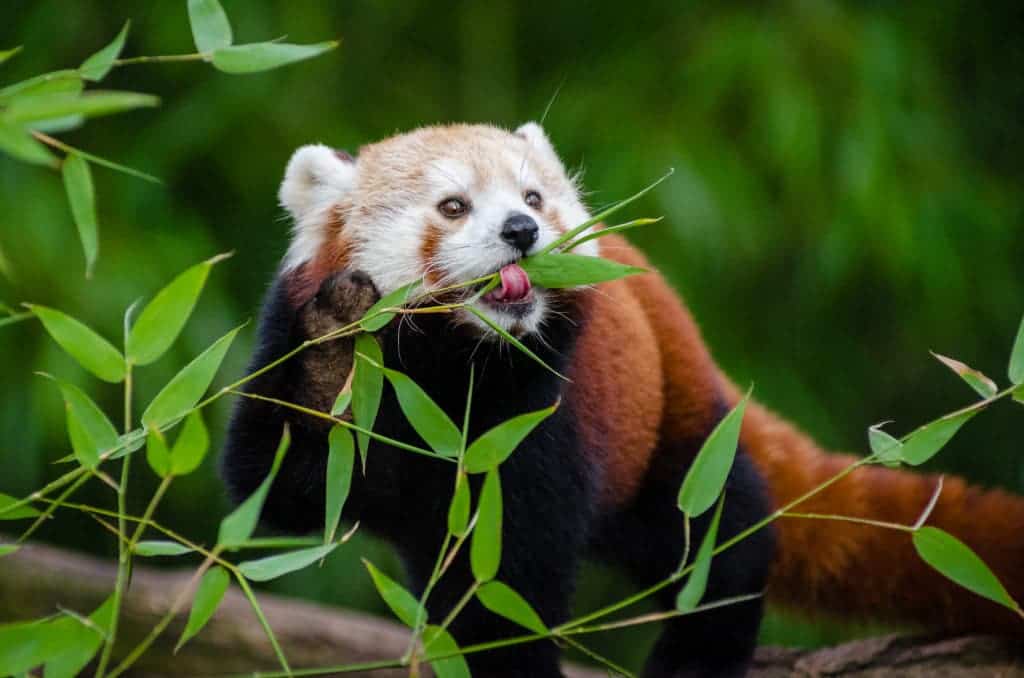Red pandas may be cute, but they have been a headache for biologists since their discovery. We may have just finally discovered where red pandas belong in the tree of life, and they are unlike anything else alive today. These small mammals are distinguishable by their rusty red–coloured fur and bushy ringed tails. They live in Southern China, Myanmar, Nepal, and India in high mountains within bamboo forests. Unfortunately, they are currently endangered.
They have been confusing biologists for almost 200 years
Other names for the red panda include cat-bear, bear-cat, lesser panda, fox bear, Himalayan racoon, and firefox (yes, the web browser is named after it). When they were first discovered by Frédéric Cuvier in 1825, he placed them in the same family as racoons because of their head shape, teeth, and ringed tails. A 1977 Nature paper also placed red pandas in the same family as racoons. Then, because of their similarity to panda bears and DNA composition, red pandas were thought to be part of the bear family. Now, they are the only members of the Ailuridae family, which is most closely related to the group containing weasels, racoons, and skunks.

Their closest relatives are long gone
Red pandas have no living relatives.Their most recent fossil ancestor, Parailurus, had a large distribution across Eurasia tens of millions of years ago. There may have been three different species of Parailurus that are all larger and had a more robust head and jaw than the red panda. The family, Ailuridae, contains seven extinct genera of animals. Fossils of jaws and other bones from extinct red panda relatives have been found in Spain, Eastern Europe, and the US. The UK is also home to a giant panda—no it’s not the cuddly black and white giant panda, but an extinct relative of the red panda. A lower jaw and fossil molar of this cougar-sized beast were found in 1888.
Almost a wah?
An English naturalist, Major General Thomas Hardwicke, presented the discovery of the red panda to the Linnean Society in London in 1821. He was likely the first Western scientist to discover the red panda, which he did so during his service in India. He gave a presentation entitled “Description of a new Genus of the Class Mammalia, from the Himalaya Chain of Hills Between Nepal and the Snowy Mountains.” He thought that it should be called a “Wah” because of the sound of its call for which the locals called it the Wha or Chitwha. Hardwicke’s paper was only published two years after Cuvier’s description in 1825, which meant that he lost the right to name the species.

Red pandas are not giant pandas
Actually, red pandas were the first animal to be called “panda”. Frédéric Cuvier, a French zoologist, first described the red panda in 1825 and called it Ailurus fulgens (fire-coloured or shining cat) after its cat-like appearance and bright fur colour. The origin of “panda” is unknown but could be from the Himalayan language or the French name for the Roman goddess of peace and travellers. The giant panda was not described until 1873 and also named panda because of its similarities to the red panda.

Both the red panda and giant panda eat mostly bamboo and live in high-altitude forests in Asia. Both pandas have a sort of thumb created from a modified wrist bone that is only used for holding the bamboo when they feed. This is an example of convergent evolution, as the animals are not closely related, though the thumbs evolved in the two pandas for different reasons. In contrast, giant pandas are not picky at all and will eat every part of bamboo, while red pandas only eat leaf tips and shoots, which are more nutritious.
Vegetarian by choice
Although red pandas are most closely related to carnivores and they have a carnivore stomach, they mostly eat bamboo and other plants. On rare occasions, they’ll hunt a small mammal or bird and eat bird eggs. This trait is also similar to most species of bears, which also eat a mostly vegetarian diet, with the exception of the polar bear.

Other unique facts
When presented with water and sweetened water, red pandas preferred the water with artificial sweeteners, making them the only known non-primate to be able to taste aspartame. In colder temperatures, red pandas become dormant, with a very low metabolism rate, which they only shake out of to get food. Additionally, they mark their territory with a clear liquid produced by glands between their footpads. The red pandas have a cone-like structure at the bottom of their tongues to test odours and bring items close to a gland in their mouths.

Even though we know how to classify red pandas, they are still unique animals that need our protection so that they don’t go the way of the rest of their taxonomic family.


